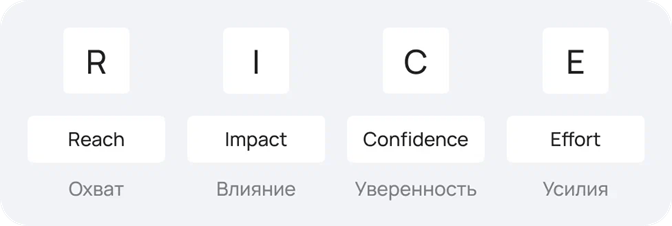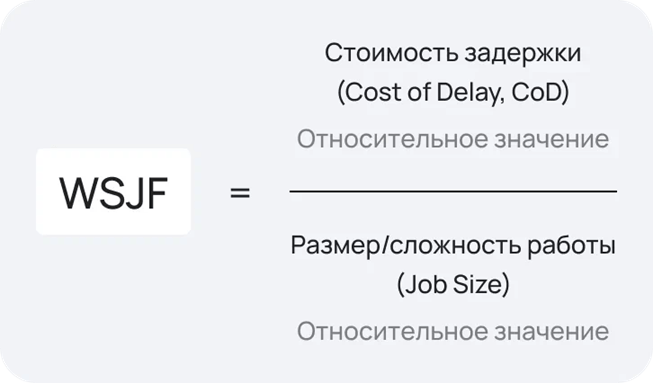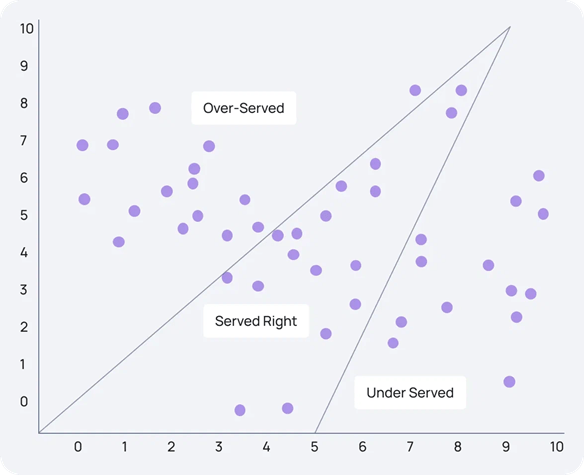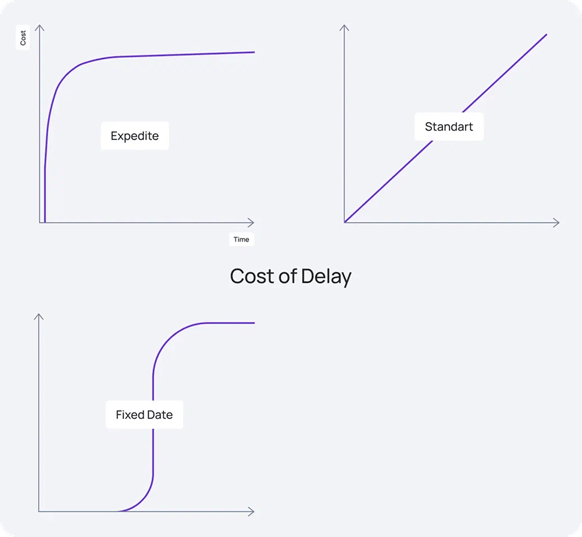Prioritizing tasks is a key skill for any project manager. However, it can be difficult to decide which tasks are really important and which can be postponed.
In this article, we’ll look at the main prioritization methods that will help you focus on what’s important and achieve results faster, and tell you how to apply popular and unconventional prioritization techniques to make informed decisions.
What is task prioritization
Task prioritization is the process of ranking work items by their importance and urgency. The goal of prioritization is to focus the team’s efforts on the most important and valuable tasks. Focusing on priorities allows you to get the most out of your invested resources and achieve business goals in a timely manner.
For example, in software development, the project manager can determine the sequence of implementation of features or epics, as well as their composition, so that the product is released on time and meets the expectations of users.
The connection between prioritization and team productivity is obvious: when employees know what to focus on first, they work more coherently and efficiently. At the same time, neglecting prioritization often leads to the “squirrel-in-a-wheel syndrome”, when the team works hard but does not achieve meaningful results. Therefore, prioritization is one of the most important skills of a manager and the team as a whole.
It is especially important to consider prioritization in the context of alignment of the developed functionality with the customer’s specification in the case of project work and product-market fit in the case of product development. These aspects of prioritization help ensure that the team is not only effective but also working in the right direction to meet key requirements and expectations.
What role does prioritization play in development management
In B2B product development management, prioritization serves as a tool to make informed decisions, make the best use of resources, and make the process transparent to all stakeholders:
1. Managing the development backlog
When creating complex B2B solutions, such as an ERP system, the backlog can contain hundreds of tasks. Prioritization helps to highlight the 20% of functionality that will deliver 80% of the value. So, for example, developing a financial reporting module may be more important than improving the admin dashboard interface.
“The combination of prioritization techniques and a development management system is the key to an effective backlog organization. By applying models such as ICE or RICE, the team doesn’t just make a list of tasks, but creates a dynamic, self-organizing backlog. This helps the team to always focus on the most valuable tasks, even when priorities change.”
– Ksenia Filippova, SimpleOne SDLC Product Owner
2. Resource allocation and sprint planning
When project resources and deadlines are limited, prioritization helps to allocate developers’ time optimally – it helps the team to take the most important tasks to work. This way, the project benefits faster, and important functionality appears sooner. If something doesn’t go according to plan, clear priorities help the team to quickly decide what to focus on first.
3. Strategic decision making
When developing a B2B product, prioritization helps you choose the direction of development based on the needs of your target customers and the market situation, and focus on functionality that solves the most pressing user problems. This is especially important in the B2B segment, where the sales cycle is usually long. The right priorities help to create a product that is easier to sell and implement in large companies.
4. Balance short-term and long-term goals
In B2B, it’s important to meet current customer needs while keeping long-term competitiveness in mind. For example, a team developing an HR platform might alternate between making quick tweaks to a timekeeping system and creating an innovative predictive analytics module for employee turnover.
5. Communicating with customers and investors
Clear prioritization allows to justify the choice of tasks to stakeholders. When a team uses clear methods for assessing the importance of tasks, it can explain its decisions with numbers and facts – this helps avoid disputes based on personal opinions alone. This approach builds trust between the development team and other departments in the company. As a result, it is easier for stakeholders to accept the chosen product development strategy.
Task prioritization models
Prioritization is often more difficult than it seems at first glance. Instead of the expected 15 minutes, the process can take hours, and the result can cause disputes in the team.
Why does this happen? People tend to prioritize their own ideas, even if they are less important to the project as a whole. New, untested concepts often seem more appealing than time-tested solutions. In addition, it can be difficult to estimate the effort required to realize each task, especially in large projects.
To avoid subjectivity and take into account all important factors, it is worth using special prioritization methods. They help to structure the decision-making process and provide a more objective approach to task evaluation. Instead of relying solely on intuition or personal preferences, the team can rely on clear criteria and mathematical models. This not only simplifies the prioritization process, but also makes it more transparent and informed for everyone involved in the project.
RICE Model
The RICE model is a task prioritization method that helps teams make informed decisions about which projects or features to develop first. The name of the model is an acronym consisting of the first letters of the four main factors:
- Reach (reach) – estimates how many users or customers will be affected by a proposed change over a given period. For example, if the new functionality will affect 1,000 users per quarter, the Reach value would be 1,000.
- Impact – determines how much impact the change will have on each user. Typically a scale of 0.25 (minimum impact) to 3 (maximum impact) is used.
- Confidence – reflects how confident the team is in their estimates. It is expressed as a percentage: 100% – full confidence, 50% – low confidence.
- Effort – an estimate of the time required to implement the project, usually expressed in person-months.
The formula used to calculate priority using the RICE model is:
| RICE score = (Reach * Impact * Confidence) / Effort
Projects with a higher RICE score are considered a higher priority.
The advantage of this model is that it allows for an objective comparison of very different ideas. For example, the team can evaluate what is more important: improving the design of the homepage or adding new payment options.
However, RICE is a decision support tool, not a substitute for common sense. Sometimes projects with a low RICE score may be implemented earlier due to strategic considerations or dependencies between tasks.
ICE Model
The ICE model is a simple and quick method of task prioritization created by Sean Ellis, known for introducing the term Growth Hacking. The name of the model is an abbreviation of three factors:
- Impact – how much impact the task will have on key product or business metrics.
- Confidence – how confident the team is in their estimates of impact and ease of implementation.
- Ease (ease) – how easy it is to implement the task given the resources available.
| Each factor is scored on a scale of 1 to 10. The values are then multiplied to get the final ICE score. The tasks with the highest score are prioritized.
Among the advantages of ICE speed of work on this model – the assessment can be carried out in a few minutes. Also, this method is quite simple and versatile, it can be easily applied to the evaluation of heterogeneous tasks.
Nevertheless, the method has disadvantages, for example, it depends quite heavily on people’s subjective assessments. An accurate assessment of priorities requires expertise in both business aspects and technical nuances.
ICE is especially useful for fast backlog grooming or selecting experiments for product growth. To get the most out of the model, it’s worth using it in conjunction with other prioritization methods to make informed decisions.
The WSJF Model
The WSJF model (Weighted Shortest Job First) is a task prioritization method developed within the Agile and Lean approaches. WSJF helps teams determine which tasks should be done first, based on their business value and turnaround time.
The basic idea behind WSJF is to maximize the value of work per unit of time. The model takes into account two factors:
1. Cost of Delay (CoD) – the cost of delay. It is the sum of three components:
- value to the business;
- the urgency or criticality of the task;
- reduction of risk or opportunity.
2. Job Size – The amount of work or time required to complete the job.
| The WSJF formula is as follows: WSJF = CoD / Job Size
The higher the WSJF value, the higher the priority of the task.
Applying WSJF helps teams focus on tasks that deliver the most value in the shortest amount of time and avoid getting stuck on large, long projects with low returns. The model helps balance urgent and important tasks.
WSJF is great for prioritizing product backlogs, managing project portfolios, and making resource allocation decisions. This method is particularly useful in resource-constrained environments where it is important to select tasks that will deliver the most value in the short term.
User Story Mapping
User Story Mapping is a visual task prioritization method that helps development teams create products with user experience in mind. This approach allows you to see the big picture of a product and break it down into manageable parts.
The main elements of User Story Mapping:
- User Stories – short descriptions of features from the user’s perspective.
- Backbone – a sequence of basic steps that the user performs when interacting with the product.
- Tasks – detailed actions required to implement each step of the framework.
- Tasks – detailed actions required to implement each step of the framework.
- Priorities – arrangement of tasks vertically according to their importance.
Map creation process:
- Define the basic user steps and create a wireframe.
- Add detailed tasks under each step of the wireframe.
- Prioritize tasks by arranging them vertically: the most important ones at the top.
- Divide the wireframe into releases or MVPs with horizontal lines.
Among the benefits of the method is the visualization of the complete user journey, which helps focus on value creation. User Story Mapping also makes it easy to identify MVP traits, which is especially useful when developing complex products or dealing with a large number of requirements.
MoSCoW
The MoSCoW method is an approach to task prioritization that helps teams and managers focus on the most important aspects of a project. The name of the method is an acronym formed from the first letters of the four prioritization categories:
- Must have: Critical tasks without which the project cannot be considered successful.
- Should have (should have): important but not critical tasks that add significant value to the project.
- Could have (can be done): desirable but not mandatory tasks that improve the project, but their absence does not affect core functionality.
- Won’t have (won’t be done): tasks that are intentionally excluded from the current scope of work.
Applying MoSCoW allows you to quickly identify the most important elements of a project, allocate resources efficiently, and focus on creating an MVP. However, the method has limitations: subjectivity in categorizing tasks, lack of clear criteria for evaluating the importance of tasks, and the risk of overestimating the number of Must have tasks
MoSCoW is particularly useful in new product development, project management with limited resources, and in situations where you need to make quick decisions about priorities. This method helps teams avoid overload and focus on what’s really important for project success.
Opportunity Scoring
Opportunity Scoring is a task prioritization method that helps product teams identify the most promising areas of product development. The essence of the method is to analyze the gap between the importance of certain features for users and their satisfaction with the current implementation of these features.
To apply Opportunity Scoring:
1. describe the features or possible outcomes of using the product;
2. conduct a user survey asking users to rate each feature on two criteria: importance (how important it is to the user) and satisfaction (how satisfied the user is with the current implementation);
3. use a formula to calculate the feature score:
| Score = Importance + (Importance – Satisfaction)
4. Analyze the result – functionality with high importance and low satisfaction are considered to be the most promising for improvement.
Opportunity Scoring allows you to focus on the aspects of the product that are really important to users and helps to identify areas where the product fails to meet customer expectations. The method also provides objective data for making decisions about product development.
Opportunity Scoring is especially useful when working on existing products, when you need to prioritize improvements.
Buy-a-Feature
Buy-a-Feature is an interactive task prioritization method that helps product teams identify the most valuable functionality for users. The essence of the method is to simulate the process of participants buying a product feature.
How Buy-a-Feature works:
- Make a list of possible product improvements;
- assign a “price” to each feature based on complexity of implementation or resource cost;
- assemble a group of participants (users or stakeholders);
- allocate a certain amount of “money” to each participant;
- suggest that participants “buy” the features they consider most important;
- observe the process and discuss participants’ decisions.
The method very clearly demonstrates limited resources and encourages participants to discuss and make decisions together. Buy-a-feature can be used to reveal users’ non-obvious priorities and create a non-standard atmosphere for product discussion.
Buy-a-Feature can help when a team is faced with a difficult choice between multiple potential features with limited resources. This method helps not only to prioritize but also to better understand user needs and motivations.
Cost of Delay
Cost of Delay (CoD) is a task prioritization method that helps teams assess the economic value of completing a project on time. The essence of the method is to quantify the loss from delaying the implementation of a feature or project.
To calculate Cost of Delay:
- estimate the potential profit from the project per unit of time (e.g., per month);
- determine the time required to complete the project;
- divide the expected profit by the realization time.
The resulting number shows how much money the company loses each month due to project delays.
The delay costing method gives the team objective data for decision making and helps to better allocate resources between projects. The result can be an argument for discussing priorities with stakeholders. The method takes into account not only costs, but also lost profits. Nevertheless, when applying the method, there is a risk to focus too much on short-term financial indicators and fail to take into account non-financial factors important for the business
Cost of Delay is particularly useful when managing project portfolios and making decisions about new product launches, it helps teams focus on projects that will deliver the greatest economic benefit in the shortest timeframe.
Summary
Task prioritization is an integral part of successful project management and product development. Each prioritization method has its own benefits and application, allowing teams to choose the most appropriate tool for their particular situation.
The right method will allow you to focus on the most important tasks, allocate resources efficiently, and make informed decisions. This is especially important under the resource and time constraints that characterize most projects. Regardless of the method chosen, the key to successful prioritization is regular evaluation and reassessment of tasks, as well as flexibility to adapt priorities to changing project conditions and user needs.





